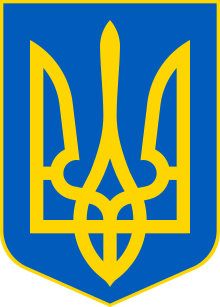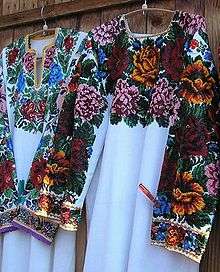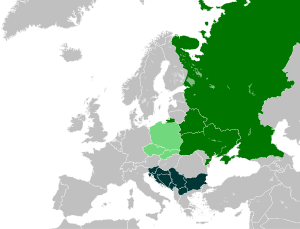Hutsuls
|
Hutsuls, 1934 | |
| Total population | |
|---|---|
| 25,290 | |
| Regions with significant populations | |
| 21,400[1] | |
| 3,890[2] | |
| Languages | |
| Ukrainian language | |
| Religion | |
| Predominantly Ukrainian Greek Catholic or Orthodox, with Roman Catholic minorities | |
| Related ethnic groups | |
| Boykos, Lemkos, Dolynians | |
| Part of a series on |
| Ukrainians |
|---|
 |
| Diaspora |
|
see Template:Ukrainian diaspora |
| Closely-related peoples |
|
East Slavs (parent group) Boykos · Hutsuls · Lemkos · Rusyns Poleszuks · Kuban Cossacks Pannonian Rusyns |
| Culture |
|
Architecture · Art · Cinema · Cuisine Dance · Language · Literature · Music Sport · Theater |
| Religion |
|
Eastern Orthodox (Ukrainian) Greek Catholicism Roman Catholicism Judaism |
| Languages and dialects |
|
Ukrainian Russian · Canadian Ukrainian · Rusyn · Pannonian Rusyn Balachka · Surzhyk · Lemko |
|
History · Rulers List of Ukrainians |
Hutsuls (Ukrainian: гуцули, hutsuly; Polish: Hucuł, plural Huculi, Hucułowie; Romanian: huțul, plural huțuli) are an ethno-cultural group of Ukrainians,[3][4][5][6] who for centuries have inhabited the Carpathian mountains, mainly in Ukraine and in the northern extremity of Romania (in the areas of Bukovina and Maramureş). Hutsuls regard themselves as being part of the broader Rusyn ethnic minority and/or as Ukrainian highlanders.
Etymology
There are different versions for the origins of the name Hutsul. An explanation is that it comes from the Romanian word for "outlaw" (cf. Rom. hoţ—"thief", hoţul—"the thief"). Other explanations place their origins in the Slavic kochul—"wanderer", "migrant"—in reference to their semi-nomadic lifestyle, to the name of the Turkic tribe of the Uzy, and even to the name of the Moravian Grand Duke Hetsyla.[7] However these are obsolete and non-academic assertions. No valid theories have been proposed yet. The name is mostly an exonym, used by neighbouring groups and not Hutsuls themselves, although some have embraced it.
History and origins

Hutsuls inhabit areas situated between the south-east of those inhabited by the Boykos, down to the northern part of the Romanian segment of the Carpathians.
Several hypotheses account for the origin of the Hutsuls. According to Romanian historian Nicolae Iorga, "huțuli" or "huțani" are denationalized Romanians.[8] Other opinions show that Hutsuls descend from the White Croats, a Slavic tribe that inhabited the area from the 4th until the 12th century, or from the Slavic tribe of the Ulichs, who had to leave their previous homes near the Southern Bug river under pressure from the Pechenegs.[9] According to Ukrainian sources, Hutsuls identify themselves as a part of Ukrainian ethnos, having at the same time their local identity as a sub-ethnos.[10] However, many Rusyns disagree.
Language
Hutsul is usually considered to be a dialect of Western Ukrainian with some Polish influences.[11][12][13][14][15] However, some linguists regard it as a form of the Rusyn language.[16] It also contains old loanwords from Romanian.
Due to the current educational system, the Hutsul dialect is in danger of extinction. Since the annexation of Transcarpathia by Stalin compulsory education has been conducted only in standardized literary Ukrainian. In recent times there has been a roots movement to keep the traditional Hutsul language alive.
Way of life and culture

Traditional Hutsul culture is often represented by the colorful and intricate craftsmanship of their clothing, sculpture, architecture, woodworking, metalworking (especially in brass), rug weaving, pottery, and egg decorating (see pysanka). Along with other Hutsul traditions, as well as their songs and dances, this culture is often celebrated and highlighted by the different countries that Hutsuls inhabit.
Ukrainian Hutsul culture bears a resemblance to neighboring cultures of western and southwestern Ukraine,[17][18] particularly Lemkos and Boykos. These groups also share similarities with other Slavic highlander peoples, such as the Gorals in Poland and Slovakia.[19] Similarities have also been noted with some Vlach cultures such as the Moravian Wallachians in the Czech Republic, as well as some cultures in Romania.[20] Most Hutsuls belong to the Ukrainian Greek Catholic Church and the Ukrainian Orthodox Church.
Hutsul society was traditionally based on forestry and logging, as well as cattle and sheep breeding; the Hutsuls are credited with having created the breed of horse known as the Hucul pony. One of the main attributes of Hutsul males is their bartok, a small head axe on a long handle. They use unique musical instruments, including the "trembita" (trâmbiţa), a type of alpenhorn, as well multiple varieties of the fife, or sopilka, that are used to create unique folk melodies and rhythms. Also frequently used are the bagpipe (duda), the Jew's harp (drymba), and the hammered dulcimer (tsymbaly).
The Hutsuls served as an inspiration for many writers, such as Ivan Franko, Lesya Ukrainka, Mykhailo Kotsiubynsky, Vasyl Stefanik, Marko Cheremshyna, Mihail Sadoveanu and Stanisław Vincenz, and painters such as Kazimierz Sichulski and Teodor Axentowicz—famous for his portraits and subtle scenes of Hutsul life—and Galyna Zubchenko. Sergei Parajanov's 1965 film Shadows of Forgotten Ancestors (Тіні забутих предків), which is based on the book by Mykhailo Kotsiubynsky, portrays scenes of traditional Hutsul life.
Every summer, the village of Sheshory in Ukraine hosts a three-day international festival of folk music and art. Two Hutsul-related museums are located in Kolomyia, Ukraine: the Pysanky museum and the Museum of Hutsul and Pokuttya Folk Art. Traditional Hutsul sounds and moves were effectively used by the Ukrainian winner of the 2004 Eurovision song contest, Ruslana Lyzhychko.
Notable people
- Matei Vişniec, playwright
- Aaron Husul, sports writer[21]
- Thomas Bell, writer
- Oksana Beysiuk, folk artist[22]
- Marko Cheremshyna, writer
- Oleksa Dovbush (Довбуш Олекса)
- Vasile Hutopilă, painter
- Mickola Vorokhta, painter, Merited Artist of Ukraine
- Volodymyr Ivasyuk, composer
- Elisabeta Lipă, multiple world and Olympic rowing champion
- Ivan Malkovych, publisher
- Yuri Shkriblyak, sculptor, carver on tree
- Mariya Yaremchuk, singer
- Nazariy Yaremchuk, singer
- Eudokia Sorochaniuk, artist[23]
See also
References
- ↑ http://2001.ukrcensus.gov.ua/rus/results/nationality_population/nationality_popul2/select_55?box=5.5W&rz=1_1&rz_b=2_1&k_t=00&botton=cens_db
- ↑ http://www.eliznik.org.uk/RomaniaHistory/minority-hutsul-villages.htm
- ↑ Encyclopedia of Ukraine: Hutsuls(English)
- ↑ Richard T.Schaefer (ed.), 2008, Encyclopedia of Race, Ethnicity, and Society, Volume 1, SAGE Publications, p. 1341.
- ↑ James Stuart Olson, Lee Brigance Pappas & Nicholas Charles Pappas, 1994, An Ethnohistorical Dictionary of the Russian and Soviet Empires, Greenwood Publishing Group, pp. 109–110.
- ↑ На Закарпатті Рахівська районна рада рада звернулася з протестом до Президента та Генпрокуратури проти рішення обласної ради про визнання національності "русин" - UA-REPORTER....
- ↑ "Hutsulshchyna: The Name and Origin". KosivArt. Retrieved 2008-07-23.
- ↑ Nicolae Iorga, Românismul in trecutul Bucovinei, BUCURESTI, 1938, pag.1
- ↑ "1. ВСТУПНІ ЗАВВАГИ. Юрій Шевельов. Історична фонологія української мови." (in Ukrainian). Retrieved 2008-07-23.
- ↑ "На Закарпатті Рахівська районна рада рада звернулася з протестом до Президента та Генпрокуратури проти рішення обласної ради про визнання національності "русин" - UA-REPORTER.COM" (in Ukrainian). Retrieved 2008-07-23.
- ↑ "Youth organizations of Prykarpattia initiate giving regional status to Hutsul dialect". Ukrainian Independent Information Agency. 2006-06-21. Retrieved 2008-07-23.
- ↑ Clark, Kathy and Bill (1997-07-12). "Kosmach". Kathy and Bill Clark's Ukrainian Vacation. Retrieved 2008-07-23.
- ↑ "The Hutsuls People". Ensemble "Halychyna". Archived from the original on 2008-05-22. Retrieved 2008-07-23.
- ↑ Volodymyr Kubijovyc, ed. (1989). "Hutsul region". Encyclopedia of Ukraine. 2. University of Toronto Press. Retrieved 2008-07-23.
- ↑ "Hutsules" (in French). Archived from the original on 2008-05-21. Retrieved 2008-07-23.
- ↑ Moser, Michael (2016). ""Rusyn"". In Tomasz Kamusella, Motoki Nomachi & Catherine Gibson. The Palgrave Handbook of Slavic Languages, Identities and Borders. Basingstoke UK: Palgrave Macmillan. p. 132., p. 125.
- ↑ "Dress". encyclopediaofukraine.com. Retrieved 2014-09-14.
- ↑ http://www.nat.com.ua/ukrainian_folk_costume.html
- ↑ http://www.pgsa.org/Towns/Gorale.htm
- ↑ "Ukrainian Tribal Divisions and Ethnographic Groups". web.archive.org. Retrieved 2014-09-14.
- ↑ Aaron Husul
- ↑ Oksana Beysiuk
- ↑ Eudokia Sorochaniuk
External links
| Wikimedia Commons has media related to Hutsuls. |
- hutsul.museum National Museum of Hutsulshchyna and Pokuttya Folk Art
- Romanian-Hutsul and Hutsul-English glossaries
- Huţuls of northern Moldavia
- Introduction to Hutsul Country
- Hutsul Portal (mostly in Romanian)
- Photo exposition about Hutsul people in Ukraine
%2C_1934.jpg)
